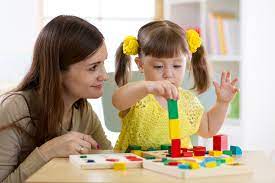The Power of Positive Reinforcement
Applied Behavior Analysis is a scientific approach to understanding human behavior . Our ABA professionals work in a safe, child-friendly environment to help understand your child’s developmental needs, and help them learn positive behaviors that they can apply throughout their lives.

Identifying behaviors and skills you want your child to master
Set goals and outcomes
Measuring progress
Evaluating the child' s existing skill set
Develop and follow a treatment plan
Review your child' s progress over time and adjust as needed
Our Approach ?
Our primary purpose of ABA treatment is to give children and their families/caregivers the tools they need to make socially significant changes. We have used this type of therapy successfully with children with behavioral problems (specifically children on the autism spectrum range or those diagnosed with Attention Deficit and Hyperactivity Disorder) by reinforcing desired behaviors or discouraging unwanted behaviors using scientifically proven tools of learning – including rewards and ‘applauds’. We also use the Rethink Application which provides parents access to their child’s therapy plan as well as progress reports.
FAQ'S
Applied Behavior Analysis (ABA) is the leading approach to improving the developmental delays specifically associated with autism, but is beneficial to children struggling with behavior problems, ADHD etc. ABA therapy is likely able to improve the quality of life of your child and help them reach their full potential. ABA therapy focuses on human behavior and aims to increase desirable behavior and minimize unwanted behaviors.
ABA therapy will address the developmental delays identified during an initial assessment of your child’s functioning across dozens of areas. With children on the autism spectrum, this often includes areas of verbal communication, like the ability to converse with parents and peers, request items, and communicate emotions and needs. Nonverbal communication, like making gestures and understanding social cues, can also be developed.
Other important target areas of ABA include social skills, play skills, potty training, self-care skills (brushing teeth, washing hands, etc.), and day-to-day living skills (getting dressed, table manners, etc.).
Simply stated: the earlier, the better.
Plenty of clinical research has demonstrated that children who start ABA therapy as early as possible (~2 years old) make the most significant improvements in their areas of deficit. In fact, children who received early intensive ABA therapy progressed to the point of being virtually indistinguishable from their neurotypical peers.
This is really determined on a child-by-child basis and cannot be determined by anyone but the BCBA and treatment team working with your child. ABA is an on-going therapy that can change and grow with your child to cater to their ever-changing needs as they continue to grow older.
Depends on how the child is responding the treatment plan. Group ABA session can be provided to help child during the transition stage.
1. Relax and stay calm.
2. Try to know the causes of the behavior (to get access to a certain item, skip going to a certain place, trying to get attention.)
3. Encourage the child to use words to communicate and ask for their needs.
4. Reinforce and reward wanted behavior for example: if the child stands up after having a meltdown in the mall and walks nicely you can mention how good he/she is walking, and you can buy ice cream for example at the end of your trip.
2. Try to know the causes of the behavior (to get access to a certain item, skip going to a certain place, trying to get attention.)
3. Encourage the child to use words to communicate and ask for their needs.
4. Reinforce and reward wanted behavior for example: if the child stands up after having a meltdown in the mall and walks nicely you can mention how good he/she is walking, and you can buy ice cream for example at the end of your trip.
As each child has individual needs, the type of therapy required will be determined by the treating therapist to ensure all the needs or problems of the child are addressed.






